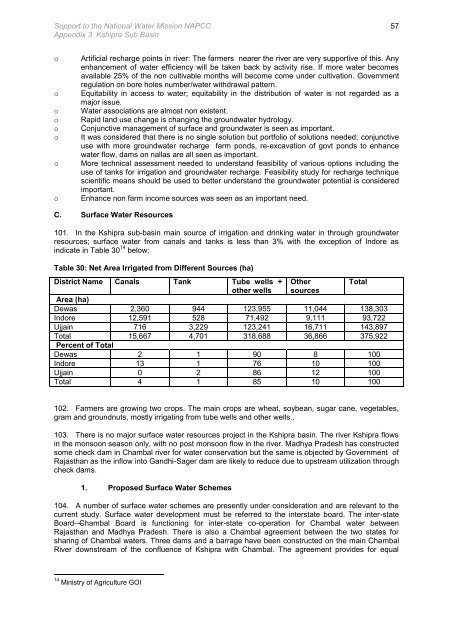Kshipra Sub Basin - Asian Development Bank
Kshipra Sub Basin - Asian Development Bank
Kshipra Sub Basin - Asian Development Bank
You also want an ePaper? Increase the reach of your titles
YUMPU automatically turns print PDFs into web optimized ePapers that Google loves.
Support to the National Water Mission NAPCC<br />
Appendix 3 <strong>Kshipra</strong> <strong>Sub</strong> <strong>Basin</strong><br />
o Artificial recharge points in river: The farmers nearer the river are very supportive of this. Any<br />
enhancement of water efficiency will be taken back by activity rise. If more water becomes<br />
available 25% of the non cultivable months will become come under cultivation. Government<br />
regulation on bore holes number/water withdrawal pattern.<br />
o Equitability in access to water; equitability in the distribution of water is not regarded as a<br />
major issue.<br />
o Water associations are almost non existent.<br />
o Rapid land use change is changing the groundwater hydrology.<br />
o Conjunctive management of surface and groundwater is seen as important.<br />
o It was considered that there is no single solution but portfolio of solutions needed; conjunctive<br />
use with more groundwater recharge farm ponds, re-excavation of govt ponds to enhance<br />
water flow, dams on nallas are all seen as important.<br />
o More technical assessment needed to understand feasibility of various options including the<br />
use of tanks for irrigation and groundwater recharge. Feasibility study for recharge technique<br />
scientific means should be used to better understand the groundwater potential is considered<br />
important.<br />
o Enhance non farm income sources was seen as an important need.<br />
C. Surface Water Resources<br />
101. In the <strong>Kshipra</strong> sub-basin main source of irrigation and drinking water in through groundwater<br />
resources; surface water from canals and tanks is less than 3% with the exception of Indore as<br />
indicate in Table 30 14 below:<br />
Table 30: Net Area Irrigated from Different Sources (ha)<br />
District Name Canals Tank Tube wells + Other<br />
Total<br />
Area (ha)<br />
other wells sources<br />
Dewas 2,360 944 123,955 11,044 138,303<br />
Indore 12,591 528 71,492 9,111 93,722<br />
Ujjain 716 3,229 123,241 16,711 143,897<br />
Total 15,667 4,701 318,688 36,866 375,922<br />
Percent of Total<br />
Dewas 2 1 90 8 100<br />
Indore 13 1 76 10 100<br />
Ujjain 0 2 86 12 100<br />
Total 4 1 85 10 100<br />
102. Farmers are growing two crops. The main crops are wheat, soybean, sugar cane, vegetables,<br />
gram and groundnuts, mostly irrigating from tube wells and other wells..<br />
103. There is no major surface water resources project in the <strong>Kshipra</strong> basin. The river <strong>Kshipra</strong> flows<br />
in the monsoon season only, with no post monsoon flow in the river. Madhya Pradesh has constructed<br />
some check dam in Chambal river for water conservation but the same is objected by Government of<br />
Rajasthan as the inflow into Gandhi-Sager dam are likely to reduce due to upstream utilization through<br />
check dams.<br />
1. Proposed Surface Water Schemes<br />
104. A number of surface water schemes are presently under consideration and are relevant to the<br />
current study. Surface water development must be referred to the interstate board. The inter-state<br />
Board-―Chambal Board is functioning for inter-state co-operation for Chambal water between<br />
Rajasthan and Madhya Pradesh. There is also a Chambal agreement between the two states for<br />
sharing of Chambal waters. Three dams and a barrage have been constructed on the main Chambal<br />
River downstream of the confluence of <strong>Kshipra</strong> with Chambal. The agreement provides for equal<br />
14 Ministry of Agriculture GOI<br />
57
















